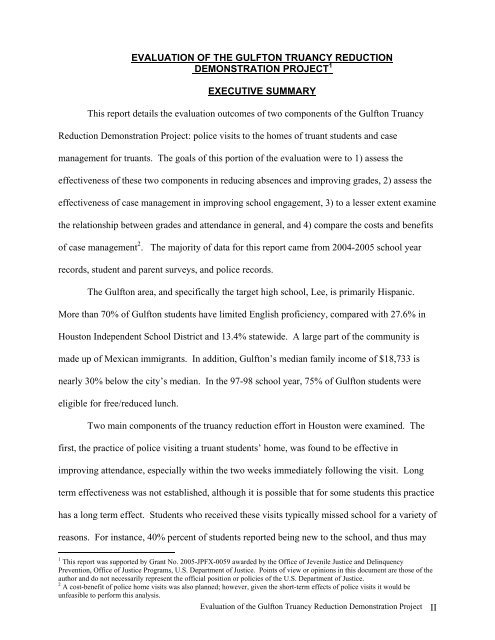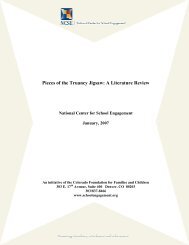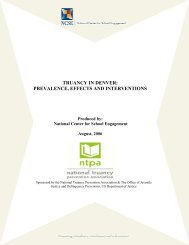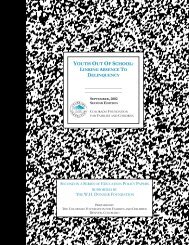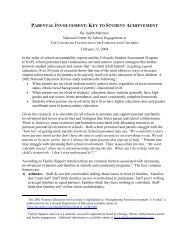Gulfton Truancy Reduction Demonstration Project, Houston, TX
Gulfton Truancy Reduction Demonstration Project, Houston, TX
Gulfton Truancy Reduction Demonstration Project, Houston, TX
You also want an ePaper? Increase the reach of your titles
YUMPU automatically turns print PDFs into web optimized ePapers that Google loves.
EVALUATION OF THE GULFTON TRUANCY REDUCTION<br />
DEMONSTRATION PROJECT 1<br />
EXECUTIVE SUMMARY<br />
This report details the evaluation outcomes of two components of the <strong>Gulfton</strong> <strong>Truancy</strong><br />
<strong>Reduction</strong> <strong>Demonstration</strong> <strong>Project</strong>: police visits to the homes of truant students and case<br />
management for truants. The goals of this portion of the evaluation were to 1) assess the<br />
effectiveness of these two components in reducing absences and improving grades, 2) assess the<br />
effectiveness of case management in improving school engagement, 3) to a lesser extent examine<br />
the relationship between grades and attendance in general, and 4) compare the costs and benefits<br />
of case management 2 . The majority of data for this report came from 2004-2005 school year<br />
records, student and parent surveys, and police records.<br />
The <strong>Gulfton</strong> area, and specifically the target high school, Lee, is primarily Hispanic.<br />
More than 70% of <strong>Gulfton</strong> students have limited English proficiency, compared with 27.6% in<br />
<strong>Houston</strong> Independent School District and 13.4% statewide. A large part of the community is<br />
made up of Mexican immigrants. In addition, <strong>Gulfton</strong>’s median family income of $18,733 is<br />
nearly 30% below the city’s median. In the 97-98 school year, 75% of <strong>Gulfton</strong> students were<br />
eligible for free/reduced lunch.<br />
Two main components of the truancy reduction effort in <strong>Houston</strong> were examined. The<br />
first, the practice of police visiting a truant students’ home, was found to be effective in<br />
improving attendance, especially within the two weeks immediately following the visit. Long<br />
term effectiveness was not established, although it is possible that for some students this practice<br />
has a long term effect. Students who received these visits typically missed school for a variety of<br />
reasons. For instance, 40% percent of students reported being new to the school, and thus may<br />
1 This report was supported by Grant No. 2005-JPFX-0059 awarded by the Office of Jevenile Justice and Delinquency<br />
Prevention, Office of Justice Programs, U.S. Department of Justice. Points of view or opinions in this document are those of the<br />
author and do not necessarily represent the official position or policies of the U.S. Department of Justice.<br />
2 A cost-benefit of police home visits was also planned; however, given the short-term effects of police visits it would be<br />
unfeasible to perform this analysis.<br />
Evaluation of the <strong>Gulfton</strong> <strong>Truancy</strong> <strong>Reduction</strong> <strong>Demonstration</strong> <strong>Project</strong> II


